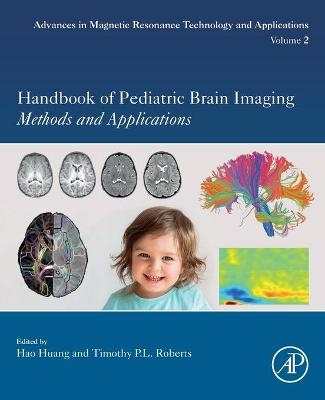
Handbook of Pediatric Brain Imaging
Academic Press Inc (Verlag)
978-0-12-816633-8 (ISBN)
Hao Huang, PhD, Professor, School of Materials Science and Engineering, Dalian University of Technology; Director, Key Laboratory of Energy Materials and Devices, Liaoning Province; Director, Experimental Center of Materials Science and Engineering, Dalian University of Technology. Doctorate in 2001-2005 from Changwon National University, Korea; In 2003, he worked as a member of the Korea Institute of Materials Science (KIMS) and the United States Massachusetts Institute of Technology (MIT) Composite Cooperation Research Group. He joined the Dalian University of Technology in 2005 and taught the doctoral course 'Energy Materials and Devices' for many years. In 2018, He established the Key Laboratory of Energy Materials & Devices (Liaoning Province). Professor Hao Huang has been committed to the research on the basic science and application technology of energy storage nanomaterials, which has brought breakthroughs to the bottleneck problems in the field of new energy materials, mainly including: (1) Macro fabrication and fine micro-structure control of nanoparticles. He designed the mass production equipment of nanoparticles by arc discharge method. The macro fabrication of multi-type nanoparticles is realized. He clarified the growth mechanism of nanoparticles in the plasmatic environment, and established the structure-activity relationship between the structural characteristics and electrochemical performance. (2) high-density and long-term energy storage of the nanoparticles. The core-shell nanostructure was designed to prevent the pulverization failure caused by volume expansion of the electrode nanomaterials during cyclic energy storage. (3) Correlation between the defect/surface structure of nanoparticles and the electrochemical reactions. The first-principles calculation and experiments are effectively combined to investigate the correlation between the defect/surface structure characteristics of nanoparticles and electrochemical reactions, providing an accurate scientific basis and effective data for the design and screening of new electrode materials. The author published 3 books including “Key Materials for High-Performance Battery (Science Press, China), and reported 108 academic papers in academic journals. The research results have been highly affirmed and recognized by experts in this field and research institutions. Over the past decade, more than 100 Ph.D and MA. students have been graduated from his lab and obtained important positions in the industries of advanced energy materials. Dr. Timothy Roberts is holder of the Oberkircher Family Chair in Pediatric Radiology and Vice-chair of Research in the Dept. of Radiology at the Children’s Hospital of Philadelphia and a tenured Professor of Radiology in the Perelman School of Medicine at the University of Pennsylvania. He received his PhD in MRI from Cambridge University in 1992. He has spent his career developing multimodal imaging and electrophysiological techniques for application to neurologic and psychiatric disorders. He has published over 300 peer-reviewed manuscripts in the field of functional and physiological imaging and has served as a grant reviewer for national funding agencies in more than a dozen countries. He serves as an Associate Editor for Frontiers in Integrative Neuroscience and has been recognized as a Distinguished Investigator of the Academy of Radiology Research (2016) and elected, in the inaugural class, as a Fellow of the American Society of Functional Neuroradiology (ASFNR) in 2019. He is a past president of the International Society for Clinical Magnetoencephalography (ISACM) as well as the ASFNR and has served on various committees of the International Society for Magnetic Resonance in Medicine and the American Society of Neuroradiology (ASNR).
Section 1 Methods 1. Special considerations for acquisition of pediatric MRI of high spatial and temporal resolution 2. Frontiers of microstructural imaging with diffusion MRI 3. Advanced tractography and structural connectome 4. Functional connectome from rs-fMRI 5. Advanced pCASL pediatric perfusion MRI 6. Advanced fetal MRI 7. Special MRI (MWF, QMS, etc) sensitive to age 8. Multi-modal (diffusion, MRI rs-fMRI, MWF, QMS) sensitive to age 9. Pediatric MRS 10. Distortion and motion artifacts
Section 2 Post-processing 11. Accurate age-specific brain atlas and parcellations 12. Segmentation with varying contrasts of pediatric MRI 13. Shape analysis of maturing cerebral cortex 14. Network and graph analysis of developing brain 15. Prediction of neurodevelopmental outcomes based on basic and advanced MRI measurements
Section 3 Electrophysiology 16. MEG system for young children and recent progresses of infant MEG 17. MEG insights into brain development 18. MEG studies of children 19. The state-of-the-art pediatric EEG and MRI-compatible EEG
Section 4 Imaging Development and Disorders Thereof 20. Early brain structural a functional development (fetal, perinatal, infant) 21. Neuroimaging of early developing brain in health and disease 22. Neuroimaging of perinatal brain disorders 23. Current status of neuroimaging of pediatric neurological disorders (e.g. HIE, epilepsy, multiple sclerosis, brain tumor, stroke) 24. Conclusion: Leveraging multi-modal neuroimaging for pediatric neurological and psychiatric disorders
| Erscheinungsdatum | 01.11.2021 |
|---|---|
| Reihe/Serie | Advances in Magnetic Resonance Technology and Applications |
| Verlagsort | San Diego |
| Sprache | englisch |
| Maße | 191 x 235 mm |
| Gewicht | 1110 g |
| Themenwelt | Informatik ► Grafik / Design ► Digitale Bildverarbeitung |
| Informatik ► Theorie / Studium ► Künstliche Intelligenz / Robotik | |
| ISBN-10 | 0-12-816633-9 / 0128166339 |
| ISBN-13 | 978-0-12-816633-8 / 9780128166338 |
| Zustand | Neuware |
| Informationen gemäß Produktsicherheitsverordnung (GPSR) | |
| Haben Sie eine Frage zum Produkt? |
aus dem Bereich


